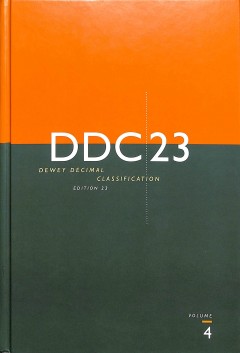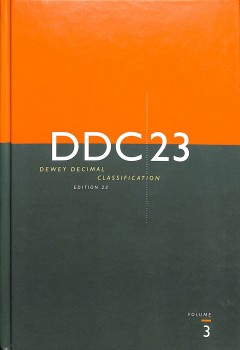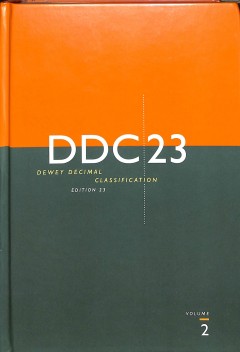Ditapis dengan

Dewey decimal classification and relative indeks volume 4
Buku ini adalah sebuah sistem klasifikasi perpustakaan yang diciptakan oleh Melvil Dewey (1851–1931) pada tahun 1876, dan sejak saat itu telah banyak dimodifikasi dan dikembangkan dalam duapuluh dua kali revisi yang telah terjadi hingga tahun 2004.
Klasifikasi Dewey muncul pada sisi buku-buku koleksi perpustakaan. Klasifikasi dilakukan berdasarkan sub…
- Edisi
- 23
- ISBN/ISSN
- 1-910608-80-7
- Deskripsi Fisik
- 965 p : 23 cm
- Judul Seri
- -
- No. Panggil
- MG DEW d

Dewey decimal classification and relative indeks volume 3
Buku ini adalah sebuah sistem klasifikasi perpustakaan yang diciptakan oleh Melvil Dewey (1851–1931) pada tahun 1876, dan sejak saat itu telah banyak dimodifikasi dan dikembangkan dalam duapuluh dua kali revisi yang telah terjadi hingga tahun 2004.
Klasifikasi Dewey muncul pada sisi buku-buku koleksi perpustakaan. Klasifik…
- Edisi
- 23
- ISBN/ISSN
- 1-910608-81-5
- Deskripsi Fisik
- 1140 p : 23 cm
- Judul Seri
- -
- No. Panggil
- MG DEW d

Dewey decimal classification and relative indeks volume 2
Buku ini adalah sebuah sistem klasifikasi perpustakaan yang diciptakan oleh Melvil Dewey (1851–1931) pada tahun 1876, dan sejak saat itu telah banyak dimodifikasi dan dikembangkan dalam duapuluh dua kali revisi yang telah terjadi hingga tahun 2004.
Klasifikasi Dewey muncul pada sisi buku-buku koleksi perpustakaan. Klasifik…
- Edisi
- 23
- ISBN/ISSN
- 978-1-910608-81-4
- Deskripsi Fisik
- xvi,1291 p :23 cm
- Judul Seri
- -
- No. Panggil
- MG DEW d

Dewey decimal classification and relative indeks volume 1
Buku ini adalah sebuah sistem klasifikasi perpustakaan yang diciptakan oleh Melvil Dewey (1851–1931) pada tahun 1876, dan sejak saat itu telah banyak dimodifikasi dan dikembangkan dalam duapuluh dua kali revisi yang telah terjadi hingga tahun 2004.
Klasifikasi Dewey muncul pada sisi buku-buku koleksi perpustakaan. Klasifik…
- Edisi
- 23
- ISBN/ISSN
- 978-1-910608-80-4
- Deskripsi Fisik
- xxxxv,779 p.,; 24 cm
- Judul Seri
- -
- No. Panggil
- MG DEW d

Integration of demand forecasts in ABC-XYZ analysis: practical investigation …
Item classification based on ABC-XYZ analysis is of high importance for strategic supply and inventory control. It is common to perform the analysis with past consumption data. In this context, the purpose of this study is to test the hypothesis that an integration of demand forecasts can improve the performance of item classification, in particular the performance of ABC-XYZ analysis
- Edisi
- Vol. 61 No. 4, 2012 pp. 445-451
- ISBN/ISSN
- 1741-0401
- Deskripsi Fisik
- 8 p.
- Judul Seri
- International Journal of Productivity and Performance Management
- No. Panggil
- ATC MR REI i

Automatic target recognition for naval traffic control using neural networks
Safety requirements in traffic control stress the importance of techniques devoted to automatic tracking of little crafts in harbor areas. Changeable sceneries and noise variability make hard the recognitions task of an automatic target recognition system. In this paper, a modular system based on neural networks for the quasi real time detection of moving targets in seaport radar images is prop…
- Edisi
- -
- ISBN/ISSN
- 0262-8856
- Deskripsi Fisik
- 7 p.
- Judul Seri
- -
- No. Panggil
- ATC PO LLO a

A generalized classification scheme for crane scheduling with interference
Nowadays, many industries rely on cranes for efficiently executing storage and retrieval operations of goods. Areas of application are, for instance, container logistics in seaports and warehousing operations in automated storage and retrieval systems. Therefore, it is not astounding that plenty scientific papers on crane scheduling in many different yet closely related logistics settings have …
- Edisi
- -
- ISBN/ISSN
- -
- Deskripsi Fisik
- 15 p.
- Judul Seri
- -
- No. Panggil
- ATC PO BOY a

A way forward for ship classification and technical services
Classification societies are one of key organizations that promote the highest standards in ship safety and quality shipping. The paper reviews the ship classification industry and identifies what the classification societies can do to add value to the maritime industry more effectively. To meet this objective, an analysis of the five competitive forces is carried out, together with an opinion …
- Edisi
- -
- ISBN/ISSN
- -
- Deskripsi Fisik
- 24 p.
- Judul Seri
- -
- No. Panggil
- ATC PO GOH a

Classifying logistics-relevant disasters: conceptual model and empirical illu…
The purpose of this paper is to use a theory-based approach to develop a new classification model for disasters that reflects their logistics implications, and to contextualise the findings by applying the model to a particular disaster situation.
- Edisi
- Vol. 4 No. 2, 2014 pp. 155-178
- ISBN/ISSN
- -
- Deskripsi Fisik
- 26 p.
- Judul Seri
- Journal of Humanitarian Logistics and Supply Chain Management
- No. Panggil
- ATC LO BOW c

International purchasing, inventory management and logistics research: An ass…
Lays a foundation for a comprehensive awareness and understanding of research in the area of international supply chain management. More specifically, reviews publications constituting a decade of the most recent research in the three areas of international purchasing, inventory management and logistics in 22 leading academic and practitioner journals for the period 1986 through 1995. Through…
- Edisi
- Vol. 18 Issue: 1, pp.6-36
- ISBN/ISSN
- -
- Deskripsi Fisik
- 33 p.
- Judul Seri
- International Journal of Operations & Production Management
- No. Panggil
- ATC LO BAB i

Distribution control at exhaust systems Europe
Discusses the selection of distribution control techniques for a manufacturer of exhaust systems. A method for this selection process is proposed and worked out for the case study company. Argues that selecting one control technique for a complete company is not advisable. Distribution control should be differentiated to clusters of products that have a similar set of product, process and mar…
- Edisi
- Vol. 26 No. 8, 1996
- ISBN/ISSN
- -
- Deskripsi Fisik
- 20 p.
- Judul Seri
- International Journal of Physical Distribution & Logistics Management
- No. Panggil
- ATC LO LEE d

Classification and prediction in customer scoring
The purpose of this paper is to discuss and assess the structural characteristics (conceptual utility) of the most popular classification and predictive techniques employed in customer relationship management and customer scoring and to evaluate their classification and predictive precision.
- Edisi
- Vol. 5 No. 1, 2010 pp. 38-53
- ISBN/ISSN
- -
- Deskripsi Fisik
- 18 p.
- Judul Seri
- Journal of Modelling in Management
- No. Panggil
- ATC LO ZUC c
 Karya Umum
Karya Umum  Filsafat
Filsafat  Agama
Agama  Ilmu-ilmu Sosial
Ilmu-ilmu Sosial  Bahasa
Bahasa  Ilmu-ilmu Murni
Ilmu-ilmu Murni  Ilmu-ilmu Terapan
Ilmu-ilmu Terapan  Kesenian, Hiburan, dan Olahraga
Kesenian, Hiburan, dan Olahraga  Kesusastraan
Kesusastraan  Geografi dan Sejarah
Geografi dan Sejarah